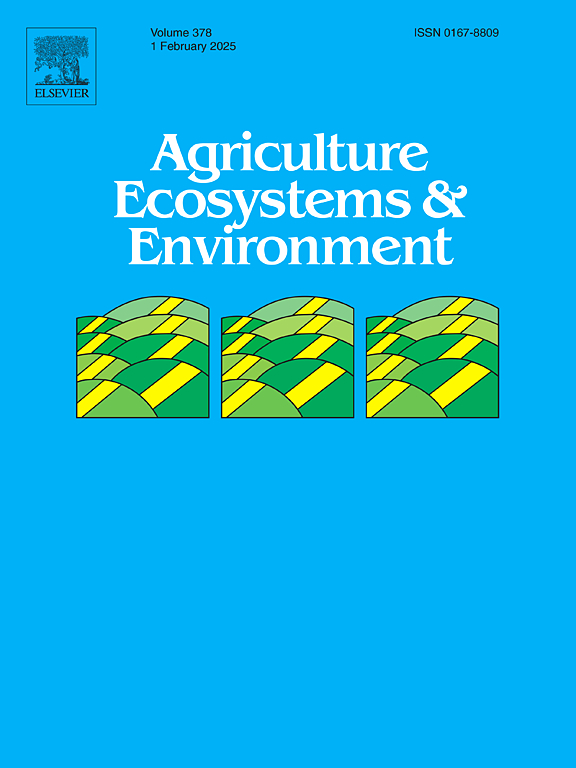Bringing soil sulfur to the forefront: How long-term cropping impacts sulfur speciation in soil organic matter fractions
IF 6
1区 农林科学
Q1 AGRICULTURE, MULTIDISCIPLINARY
引用次数: 0
Abstract
Soil sulfur (S) cycling is of increasing interest for crop S supply, given that S inputs to soils have declined due to the application of high-analysis (low-S) fertilisers and decreased atmospheric SO2 emissions. This study uses three paired sites [undisturbed (native) and cropped (up to 82 y)] from subtropical Australia to examine the impact of land use change on soil S composition. Soil organic matter (SOM) was separated into three fractions: free particulate organic matter (fPOM), occluded POM (oPOM), and fine mineral-associated organic matter (fine-MAOM), before using X-ray absorption near-edge structure (XANES) spectroscopy for analyses of S speciation. In the native soils, S speciation across the SOM fractions was distinct. Both POM fractions were dominated by reduced thiol and thio-ether groups (∼33 %), with an average S oxidation state of +2.4. In contrast, the S in the fine-MAOM was mostly oxidised sulfate ester and sulfate (44 %), with an average oxidation state of +3.9. The loss of SOM during long-term cropping caused a concomitant loss in S – up to 99 % of S was lost from the less protected fPOM fraction, while only 44 % of S was lost from the fine-MAOM. Under cropping, the bulk soil shifted to higher proportions of oxidised S. However, this was not caused by a change in S speciation within any SOM fraction but was due to the decreased contributions of POM fractions to the bulk soil. This study develops our understanding of the influence of cropping on S speciation and the role of SOM fractions in S dynamics.
将土壤硫带到前沿:长期种植如何影响土壤有机质组分中的硫形态
由于施用高分析(低硫)肥料和大气二氧化硫排放减少,土壤硫(S)循环对作物硫供应的影响越来越大。本研究使用澳大利亚亚热带的三个成对的地点[未受干扰的(原生)和种植的(高达82 y)]来研究土地利用变化对土壤S组成的影响。将土壤有机质(SOM)分为自由颗粒有机质(fPOM)、封闭颗粒有机质(oPOM)和细矿物伴生有机质(fine- maom)三部分,利用x射线吸收近边结构(XANES)光谱分析土壤S形态。在原生土壤中,土壤有机质组分间的S种形成是明显的。两个POM组分均以还原性硫醇和硫醚基团为主(~ 33 %),平均S氧化态为+2.4。而细粒maom中的S主要为氧化硫酸盐酯和硫酸盐(44 %),平均氧化态为+3.9。长期种植过程中SOM的损失导致了S的损失——保护较少的fPOM部分损失了高达99 %的S,而精细的maom部分仅损失了44 %的S。在种植过程中,大块土壤中氧化硫的比例增加,但这不是由任何SOM组分中硫形态的变化引起的,而是由于POM组分对大块土壤的贡献减少。本研究加深了我们对种植对S形态的影响以及SOM组分在S动态中的作用的理解。
本文章由计算机程序翻译,如有差异,请以英文原文为准。
求助全文
约1分钟内获得全文
求助全文
来源期刊

Agriculture, Ecosystems & Environment
环境科学-环境科学
CiteScore
11.70
自引率
9.10%
发文量
392
审稿时长
26 days
期刊介绍:
Agriculture, Ecosystems and Environment publishes scientific articles dealing with the interface between agroecosystems and the natural environment, specifically how agriculture influences the environment and how changes in that environment impact agroecosystems. Preference is given to papers from experimental and observational research at the field, system or landscape level, from studies that enhance our understanding of processes using data-based biophysical modelling, and papers that bridge scientific disciplines and integrate knowledge. All papers should be placed in an international or wide comparative context.
 求助内容:
求助内容: 应助结果提醒方式:
应助结果提醒方式:


